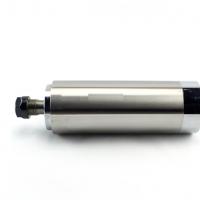A definitive answer on closed loop encoder support
- TFT
-
 Topic Author
Topic Author
- Offline
- New Member
-

Less
More
- Posts: 4
- Thank you received: 0
26 Apr 2016 17:00 #73919
by TFT
A definitive answer on closed loop encoder support was created by TFT
I am using Mach3, however I have no closed loop encoder support.
If I switch to LinuxCnc will i be able to set up closed loop with my longs stepper motor and drivers, along with the parallel port and quadrature encoder, or is there something more i need?
Thanks
If I switch to LinuxCnc will i be able to set up closed loop with my longs stepper motor and drivers, along with the parallel port and quadrature encoder, or is there something more i need?
Thanks
Please Log in or Create an account to join the conversation.
- BigJohnT
-

- Offline
- Administrator
-

Less
More
- Posts: 3990
- Thank you received: 994
27 Apr 2016 10:40 #73946
by BigJohnT
Replied by BigJohnT on topic A definitive answer on closed loop encoder support
Typically closed loop is for servos and steppers are open loop. The parallel port is pretty slow compared to hardware step generators like the
Mesa 7i76
. And of course the answer is yes you can drive steppers in velocity mode with encoder feedback. The big question is what are you trying to accomplish?
JT
JT
Please Log in or Create an account to join the conversation.
- Todd Zuercher
-

- Offline
- Platinum Member
-

Less
More
- Posts: 4689
- Thank you received: 1433
27 Apr 2016 12:56 #73950
by Todd Zuercher
Replied by Todd Zuercher on topic A definitive answer on closed loop encoder support
The short answer: Yes, but...
There are a lot of questions that need to be answered. Such as the type of encoders being used, their scale/resolution, what step and count rates are to be expected, how is it all tied together at the machine...
As John mentioned, parallel ports are rather slow. Reading an encoder with a parallel port has the same speed limitations as stepping with it. Hence your encoder resolution would be limited to no better than your stepper resolution, and rates would probably need to be limited to within a safety margin.
Using a hardware encoder counter, would allow increasing the encoder resolution and rates to a much more useful level, as would adding hardware step generation. Luckily there is relatively inexpensive hardware that can do both. A Mesa 5i25, can generate step-rates and read encoders at Mhz speeds. However I would recommend adding one of Mesa's daughter cards to add differential signalling and signal conditioning. The 7i85S, that can read 4 differential encoders (with index) and 4 differential step/dir signals.
There are a lot of questions that need to be answered. Such as the type of encoders being used, their scale/resolution, what step and count rates are to be expected, how is it all tied together at the machine...
As John mentioned, parallel ports are rather slow. Reading an encoder with a parallel port has the same speed limitations as stepping with it. Hence your encoder resolution would be limited to no better than your stepper resolution, and rates would probably need to be limited to within a safety margin.
Using a hardware encoder counter, would allow increasing the encoder resolution and rates to a much more useful level, as would adding hardware step generation. Luckily there is relatively inexpensive hardware that can do both. A Mesa 5i25, can generate step-rates and read encoders at Mhz speeds. However I would recommend adding one of Mesa's daughter cards to add differential signalling and signal conditioning. The 7i85S, that can read 4 differential encoders (with index) and 4 differential step/dir signals.
Please Log in or Create an account to join the conversation.
Time to create page: 0.312 seconds
